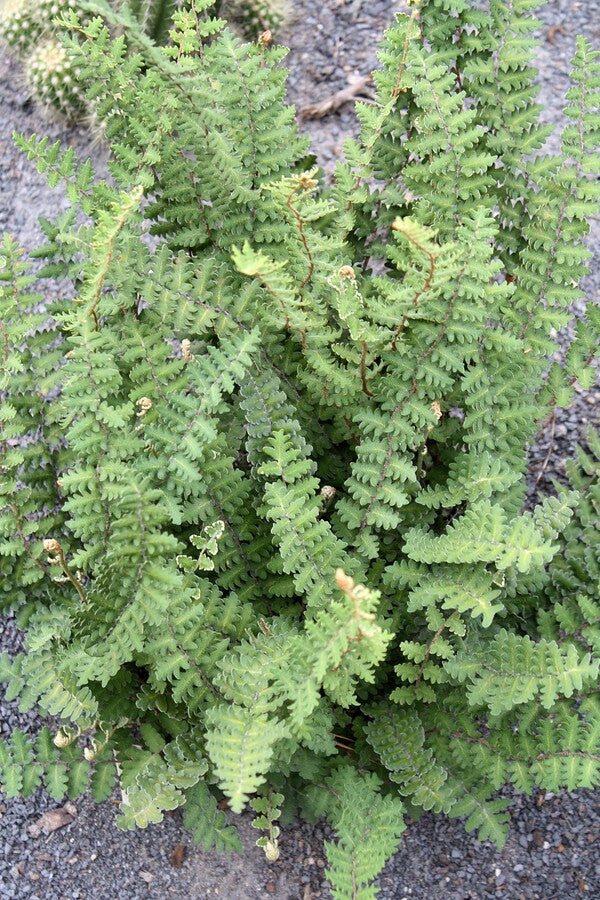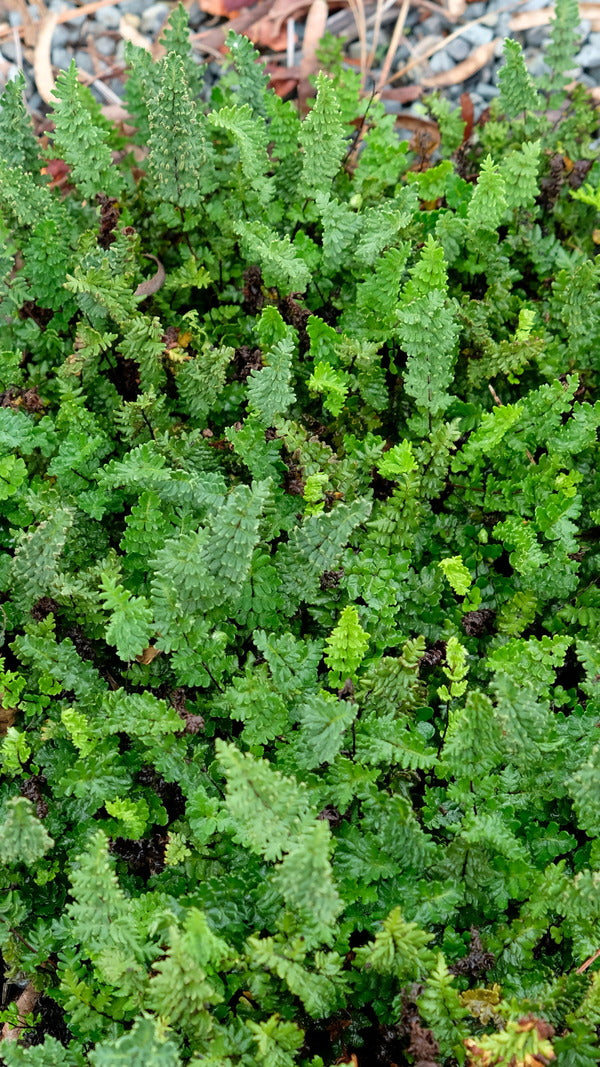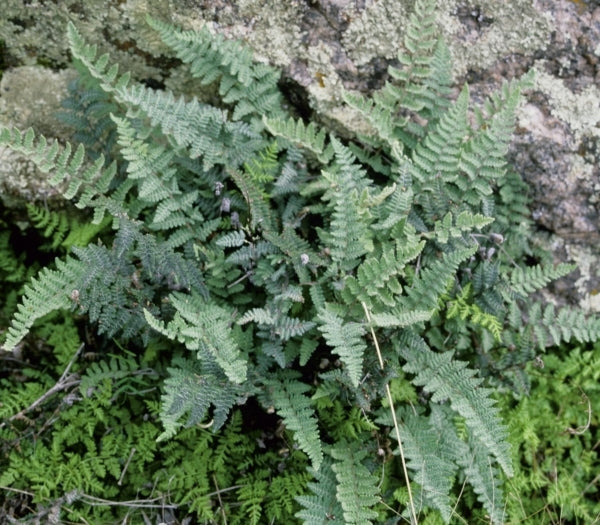It seems that almost every fern fanatic I talk with has the same opinion of dryland ferns—they’re fascinating but frustratingly difficult to grow. In my 30+ years of growing a vast number of the dryland ferns of the world, I’ve found them to be extremely frustrating if grown in the conditions any good gardener would expect them to grow in but relatively easy and care-free if grown in the manner they prefer. When I talk of dryland ferns, what I’m referring to are members of the predominantly epilithic (growing on rocks) genera Aspidotis, Astrolepis, Bommeria, Cheilanthes, Myriopteris, Pellaea, and Woodsia that grow in droughty crevices and shallow soils around rocks (fig.1).
One might expect that these species would be most abundant in truly dry regions such as the American deserts and that is, in fact, where they are most numerous, but many representatives of these otherwise desert-dwelling ferns have populations throughout most of the United States and in many other regions of the world. The ability of species from the arid environments of places like Arizona and Texas to be grown successfully in more humid climates such as the Southeastern United States is evident in the adventive and disjunct native occurrences in places like Jocassee Gorges of the Blue Ridge escarpment of South Carolina (one of the most humid and highest rainfall regions in the United States). Here I will outline my recipe for success with growing these ferns on both the humid east and winter-humid west coast and give a brief description of the most resilient and desirable species for our rock garden settings.
When and Where to Plant Dryland Ferns
I generally introduce these plants into the garden in the autumn, once the blazing summer temperatures have moderated. These ferns enjoy the opportunity to establish with less drought-stress though they are capable of tolerating month upon month without rain in the wild and springing back to life once water arrives (true xerophytes). Alternatively, I have had good success introducing them early in the spring but never during the heat of the summer without careful and consistent watering, but not overwatering.
These plants need extremely well-drained soils and do very well sandwiched between crevices in rock in elevated beds or in raised beds with ample gravel (we use PermaTill at JLBG) worked into the soil. These plants are excellent for crevice gardens. In such well drained beds, it is critical to note that they seem to all establish and thrive best when planted up against a larger rock. I tend to tuck the rhizomes up underneath the lip of the rocks and install smaller stones on the lower side to really hem them in (see fig. 2). This closely mimics the locations where they grow in the wild and has been critical in my success with these ferns. I also tend to work some organic material right around the rhizomes but only a very small amount which simulates the often-organic duff where they establish in their native habitats. The partially decomposed duff in old logs is perfect for this application. Though they are growing in very dry environments they grow in crevices that tend to maintain more of a boundary layer and thus locally higher humidity and remain perfectly drained.
Once planted, make sure the plants do not dry out during their first several weeks of establishment. If your plants have leaves that are curled and folded, they’re too dry. I usually water once a day for the first several weeks with a light watering, adjusting as needed (the plants easily show drought stress). Once established, most species rarely, if ever, need supplemental water. Most species are found in very high light situations, but many receive some protection from the direct influence of the sun through the partial shading derived from its partnered rock.
Maintaining Dryland Ferns
Annual maintenance is mostly confined to removal of old dead leaves. I tend to cut back our Myriopteris and Astrolepis in the late winter just before new fronds are produced to encourage a tidy and well-groomed appearance to the clumps. I never clip back clumps of Pellaea and chose to only remove individual fronds as they die and become unsightly. Winter hardiness is still unknown for many of these species as they appear to be capable of withstanding significantly colder conditions then occur in their native ranges. My estimates of hardiness here are best guesses and we would love to hear reports from others in colder regions.
Dryland Fern Varieties for the Home Rock Garden
We have been successful with most of the species we have trialed in our gardens, but I wanted to highlight some of the most interesting and more adaptable species for the home rock garden here.
Aspidotis densa (Cliffbrake) Though seldom included in gardens, this beautiful little rock-dwelling fern is encountered most commonly in serpentine environments in the Pacific states as well as on outcrops in the northern Rocky Mountain region. The fronds are thick-textured and held upright, giving the impression of an Italian Parsley leaf. We were quite surprised to find that this species thrived under normal rock garden conditions and in the crevice garden at Heronswood Garden in Kingston, Washington. In fact, this turned out to be one of the easiest of the dryland ferns to grow for us. We have not attempted this species at Juniper Level Botanic Garden, nor did we try it at the South Carolina Botanical Garden, but it would not surprise me if it grew under crevice garden conditions in the Southeast. This species was quite forgiving of its location in our trials in Washington and even grew along the base of the gravel bed and into the pathway. (Hardiness Zone 4a - 9b)
Astrolepis sinuata
Atrolepis sinuata (Wavy Cloakfern) This is by far the easiest of the cloakfern species to cultivate and is available from specialty nurseries. It will thrive in almost any well-drained location with full sun, but I’ve also grown it in partial sun on the fern table at Heronswood. This species does not require high calcium substrate and is generally found growing among acidic rock in its native habitat. Its adaptability is evident in the highly disjunct populations in the escarpment of South Carolina, far from its core habitat in the Chihuahuan desert. In the garden this species quickly forms an 18” wide clump with fronds 12-18” in length. Cutting back the old fronds in late winter is a great way to maintain its attractiveness. It should be divided every 4 years or so to maintain vigor in the garden. Planting with well-established, nursery-grown material is the best road to success with this species and there is no reason to remove it from its native habitat. (Hardiness Zone 7a - 9b)
Bommeria hispida 'Gila Dwarf'
Bommeria hispida (Bommer’s Fern, Dwarf Copper Fern) This is an adorable little fern that has left many a gardener scratching their head trying to figure out why they can’t seem to grow it. The answer, tuck it under a rock. I’ve grown this quite well on both coasts in humid climates by starting it in this way. It is a great addition to the crevice garden. It may spread beyond the edge of the rock but appreciates the shelter while establishing. Provide very well drained soils. This species has a single population in the eastern United States in South Carolina but is otherwise most abundant in the Chihuahuan desert. (Hardiness Zone 7b - 9b)
Cheilanthes distans
Cheilanthes distans (Bristly Cloak Fern) A true Cheilanthes (at least for now). This cute little fern is easy to grow in well-drained soils and performs particularly well in the rock and crevice garden. The fronds are extremely short and delicate reaching a maximum of 6” in length in our experience. This species grows naturally on outcrops in New Zealand and Australia. Though you would expect a plant from this range to perform well in the Pacific Northwest it also thrives in our gardens, even in partial sun, here in Raleigh, NC. (Hardiness Zone 7b - 10b)
Cheilanthes eckloniana (Ecklon’s Lip Fern) One of the few Cheilanthes that is still in the genus Cheilanthes (at least for the time being). This is one of the easiest of the dryland ferns to grow in garden conditions. Any well-drained site works well. It hails from South Africa and one of the cultivars available commercially, ‘Naude’s Neck’ was originally collected at nearly 8000’ elevation and has proven reliably hardy to zone 7b. (Hardiness Zone 7b - 9b)
Myriopteris alabamensis (Alabama Lip Fern) Though named for the state in which it was discovered, this medium-sized lip fern is more abundant in Texas and southern Arizona. In the eastern portion of its range, it is typically associated with limestone. This species is similar to Hairy Lip Fern (M. lanosa) but produces darker green and slightly smoother fronds with a tidier appearance. We have found this species to be fairly easy to cultivate here in the Southeastern United States and it grew well in Washington as well. (Hardiness Zone 7a - 10b)
Myriopteris aurea aka Cheilanthes bonariensis (Golden Lip Fern) This is one of the most unique and easily grown of the genus. The graceful clumps produce fronds that reach 18” in height and 2’ or more in width and we have been successful growing them in crevice gardens, rock gardens and even well-drained raised beds. This species has a very different appearance from the other Myriopteris and provides a very graceful and appealing visual element to the rock garden. (Hardiness Zone 7a - 9b)
Myriopteris gracillima (Lace Lip Fern) This is a tiny version of the larger species. I have found it easy to grow, under the conditions described above, in the Pacific Northwest. The fronds are generally only 4” or so in length and considerably more slender in outline than most other species. This is the only widespread native lip fern in the Pacific Northwest. It is probably not suited for Southeastern gardens but may perform well in the Northeast and Midwest? (Hardiness Zone 4a - 8b)
Myriopteris lanosa (Hairy Lip Fern) This wide-ranging species grows from the eastern states west to Texas and proves easy to cultivate under the conditions described above. Great drainage is a must, but so is moisture during the establishment phase. This species has slender rhizomes and spreads to form sizeable patches (1-2’ wide) fairly quickly. A very fine, compact form selected at Plant Delights Nursery ‘Mighty Tidy’, has become fairly widespread in the specialty trade. (Hardiness Zone 5a - 9b)
Cheilanthes lanosa 'Mighty Tidy'
Myriopteris rufa aka Cheilanthes eatonii (Eaton’s Lip Fern) This amazing fern wins the prize for having the most awesome colored fronds. The 6 – 12” long fronds are a startling bluish-silver and stand out brilliantly against darker rock. Though it may look fancy, we have found that this fern performs very well in crevice and rock gardens on both coasts if initially placed under a larger rock. (Hardiness Zone 6a – 8b)
Cheilanthes tomentosa
Myriopteris tomentosa (Woolly Lip Fern) This species is often found growing near or with Hairy Lip Fern but has longer, more upright, and paler fronds. The plants are tightly clumping and easy to grow but not easy to establish. I suggest either raising plants from spore and planting out well-established potted plants or seeking out commercial sources from among specialty nurseries for best results. (Hardiness Zone 5a – 9b)
Myriopteris wrightii aka Cheilanthes wrightii (Wright’s Lip Fern) This very small lip fern is unique among our American species in producing very short (3”) fronds attached to narrow, long-creeping rhizomes that tend to form short carpets of growth when happy. Though they often are found in shallow-soil mats on large outcrops in their native haunts of the desert Southwest, in the garden they also need the shelter of a larger rock for their rhizomes to be tucked under to get their start. (Hardiness Zone 7a - 9b)
Pellaea ovata (Zig-zag Cliffbrake Fern) Pellaea present a special challenge to establish. Some widespread species such as the common Purple Cliff Brake (Pellaea atropurpurea) have proven extremely difficult to establish from plants. Zig-zag Cliffbrake has broken the mold for us and has established well and long-term in part sun to full sun rock gardens and crevice garden conditions here at Juniper Level. This fern has a zig-zag rachis (stem) to 2’ long, and rounded blue-grey pinnae. It is found naturally on outcrops in central and west Texas and seems to benefit from a little shelter from taller plants or growing along the edge of a woodland where it can receive a break from all day sun. (Hardiness Zone 7b – 9b)
Pellaea wrightiana (Wright’s Cliffbrake) This medium-sized fern forms dense clumps of upright, blue-gray leaves with the texture of plastic. The pinnae are generally ternately compound over most of the length of the frond. This fern is most abundant in the desert Southwest where it is found in association with acidic rock outcrops but occurs as scattered disjunct populations into North and South Carolina. Among the rock-dwelling cliffbrakes, this one is perhaps the easiest to establish as long as the drainage is perfect, and the plants are started under the shelter of a larger rock. (Hardiness Zone 7b - 9b)
Pellaea viridis (Green Cliffbrake) Our experience with this Old-world species are from collections made in South Africa. Unlike the many American species, this one is completely forgiving of drainage, light and pretty much anything else you want to throw at it. It easily establishes and thrives on walls, raised beds and rock gardens in partial shade to full sun. If you’re feeling frustrated and want to start off with a success, make this the first dryland fern you introduce into your landscape. (Hardiness Zone 7a - 9b)








